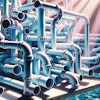
The latest, most pressing threat is drought, and what it might mean for pool people in areas of the West and Southwest, where the weather’s been bone dry.
Civilization in those areas is about to get serious about water conservation, and one of the most obvious places to cut water consumption is pools and spas. So far, the measures have been relatively mild — a municipality here or there saying you can’t top up or issuing “voluntary” restrictions, things like that.
But what’s being considered is quite sobering, and could be widespread. That should be our focus, because if the drought continues unabated, “what’s being considered” could be what is done.
And that is to make our products unusable by preventing people from filling them with water, or perhaps to deny us the right to build them. That’s where we could end up if we lose the conservation debate.
Our mission is simple: We need to use facts to fight furor, and change the debate from ecology to economy. That is, the measures we take to conserve water should both preserve our water supply and promote prosperity.
We must sharpen this point: Coming down hard on pools and spas will save very little water, and will kill jobs (ours, as it happens). Whereas pushing new conservation measures among the large water consumers — energy and food production — will save a great deal of water, and will create jobs.
According to the U.S. Geological Survey, nearly half of our fresh water is used for energy production, and another third for irrigation. The types of personal consumption we see every day — showers, dishwashers (and pools and spas) amount to only a small fraction. In fact, the entire public supply of water accounts for only 13 percent of all freshwater consumption.
Which simply means we should be talking about the agriculture and energy sectors, not pools and spas.
For instance, surface and sprinkler crop irrigation schemes are an enormous waste of water. By switching to root-drip irrigation, you would save enough water to end the drought conversation right there. And give the people who manufacture and install these systems — many of whom live right here in a America — a paycheck.
As this drought continues, we need to make public policy decision-makers realize it’s in their own interest to leave us alone. That if they squeeze us, very little fresh water will come running out, and it will hurt their economy.









































